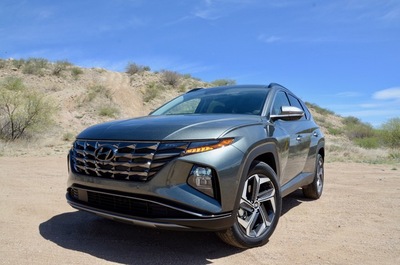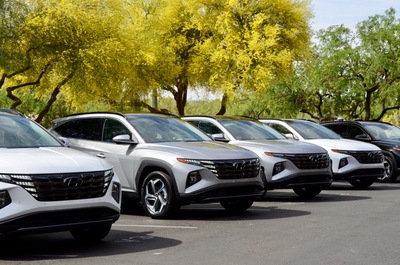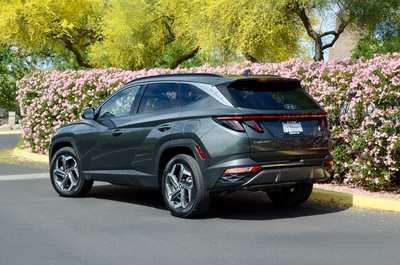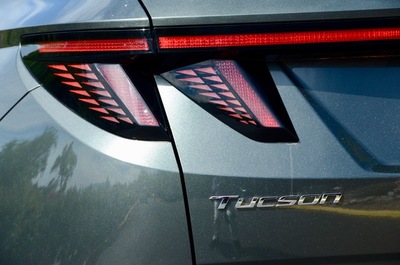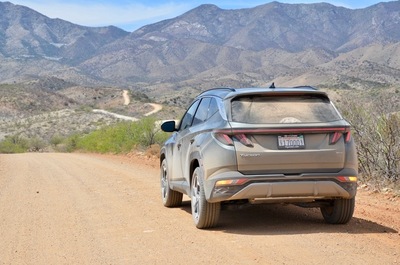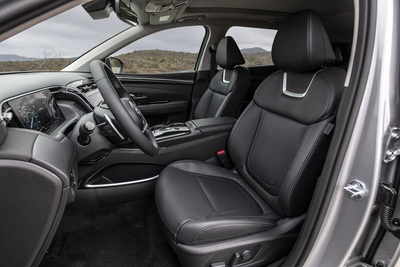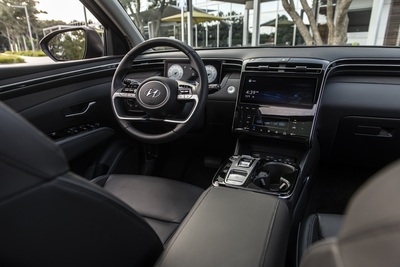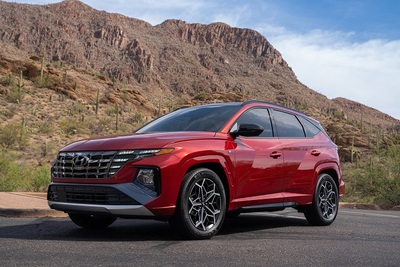2022 Hyundai Tucson First Drive - Review by Larry Nutson
First Drive
By Larry Nutson
Executive Editor and Bureau Chief
Chicago Bureau
THE AUTO CHANNEL
I just drove the new Tucson in Tucson. Yes, notwithstanding the Covid-19 pandemic, travel can be done with low risk. Tucson, Arizona was the location selected by Hyundai for a select group of auto writers to experience the all-new, fourth-generation 2022 Hyundai Tucson.
Hyundai has been doing well with first quarter SUV sales up 41%. Tucson plays a big role in Hyundai’s sales as it is its best-selling crossover utility (XSUV).
In designing and developing this complete redo of the Tucson the Hyundai team focused on improvements and changes in response to unmet needs of its customers. Namely, safety, technology, design and fuel consumption all got attention.
The Tucson sits in the compact utility segment which is bimodal when it comes to customers. Both younger and older folk buy the Tucson. Some of these focus on driver comfort, others focus more on passenger comfort and all want good cargo room.
The new Tucson will offer the choice of three different powertrains. Two of them are hybrids. All trim levels will have advanced driver-assist safety features as standard. There’s increased cabin space and an overall all-new more athletic exterior design plus premium materials on the inside. There’s also a new N-Line added to the model program.
The new Tucson architecture adds room for both passengers and cargo. The 108.5 inch wheelbase is up by 3.4 inches. Correspondingly, Tucson get longer by 6.1 inches to 182.3 inches. It’s also taller and wider. Simply put there’s more room for people and things. Cargo volume is now 38.7 cu.ft. behind the second-row seat, a 25% increase. Fold the rear seat and cargo room increases to 74.8 cu.ft.
I happened to take a look back and noted I drove the 2016 Tucson at its introduction to the media. That model also was longer and wider and with increased cargo room compared to the previous model. I see a trend here. We want our space!
I mentioned three powertrains will be available from which to choose. The standard engine is bumped up to a 187-hp 2.5-L gasoline engine (ICE) with EPA-estimated combined fuel economy of 29 mpg with front-wheel drive and 26 mpg with all-wheel drive. This 2.5-liter engine couples to an 8-speed automatic transmission.
Tucson is front-wheel drive and offers Hyundai’s HTRAC All-Wheel-Drive (AWD) system as an option. The HTRAC AWD is a multi-mode system, providing an electronic, variable-torque-split clutch with active torque control between the front and rear axles. The driver-selectable HTRAC Normal, Sport, Smart and Snow modes help provide control in all weather conditions.
Tucson Hybrid (HEV)—a first, has a 180-hp 1.6-L turbocharged gasoline engine combined with a 44.2 kW electric motor and a 1.49 kWh battery pack for an estimated 226 total system combined horsepower. The Hybrid uses a HEV-tuned six-speed automatic transmission.
The HEV is 30 percent more fuel efficient at 37 combined mpg than the standard gasoline engine, with 20 percent more torque for quick acceleration. Driving range is over 500 miles. The HEV is offered only in AWD configuration.
Tucson Plug-in Hybrid (PHEV) also uses the 180-hp 1.6-liter turbocharged gasoline engine combined with a 66.9 kW electric motor and a 13.8 kWh battery for an estimated 261 total system horsepower. This coupled with a PHEV-tuned six-speed automatic transmission and is also offered only with AWD. Estimated all-electric range (AER) is 32 miles and estimated fuel economy is more than 70 MPGe. PHEV level-2 charging capability takes less than two hours to recharge the system, using a 7.2kW on-board charger.
The new Tucson trim lineup is SE, SEL, SEL w/Convenience Package, SEL w/Premium Package, N-Line and Limited on ICE-powered models. HEV models come in Blue, SEL-Convenience and Limited. The PHEV is offered in SEL and Limited trims.
Hyundai has upped the game in equipping additional all-important safety features on the new Tucson. Forward collision avoidance with pedestrian detection is standard across the lineup. Lane keep assist, high beam assist, driver attention warning, rear occupant alert, speed limit assist and leading vehicle departure are also standard.
Available are blind spot collision avoidance, rear cross-traffic collision avoidance, safe exit warning, smart cruise control with stop and go, surround view monitor, blind-spot view monitor and parking distance warning.
I drove both the gas engine and the hybrid version of the Tucson while in Tucson. Both deliver good all-around performance. The 2.5-L with its 8-speed transmission is plenty responsive. On a mixed city/highway type drive I was getting around 30 mpg. The HEV has even better performance and on a one hour drive at mid-range speeds I was seeing 50 mpg. Hyundai’s decision to use a conventional 6-speed automatic with the hybrid is a good one. It’s a much better setup than a CVT.
Suspension is firm, but not too. Tucson has a comfortable ride with confident and assuring handling. NVH is well managed making for a quiet cabin. During a bit of light off-road driving on an unpaved, gravel and dirt desert roads in the hills outside Tucson the new Tucson was well mannered. There was good isolation over the rough roads and cabin noise remained reduced.
I like the 2022 Tucson's exterior styling with its crisp geometric patterns intersecting together on the side profile. The bright trim along the roof line sloping to the rear gives it a coupe-like look. The rear hatch is clean with its hidden rear wiper and glass-mounted logo. Photos don’t do it justice. You need to see it in person. The Tucson stands out from other look-alike crossovers.
The roomy cabin is well done with a premium look and nice material finishes. The dashboard blends across its width into the doors, wrapping around front occupants. A vertically oriented, fully integrated center panel with touchscreen and controls descends to the console with its push-button gear selector.
Prices for the new Tucson start at $24,950 for the SE with FWD and tops out at $37,350 for the Limited HEV, with a $1,185 destination charge on top of this.
The smart buy, in my opinion, is the SEL with Convenience Package HEV. It has better performance and fuel economy for $2,950 over the gasoline SEL.
More information and details can be found at www.hyundaiusa.com. Tucson gasoline and hybrid models begin availability for the U.S. market in spring 2021, with plug-in hybrid models available in summer 2021. The N Line version of the Tucson is for the enthusiast buyers, with a more aggressive exterior appearance and interior details. N Line will be available in late spring 2021.
This report comes from an invitation-only Hyundai launch event that allowed special access to the vehicle and executives. Hyundai provided my overnight accommodations, meals, and transportation.
© 2021 Larry Nutson, the Chicago Car Guy



